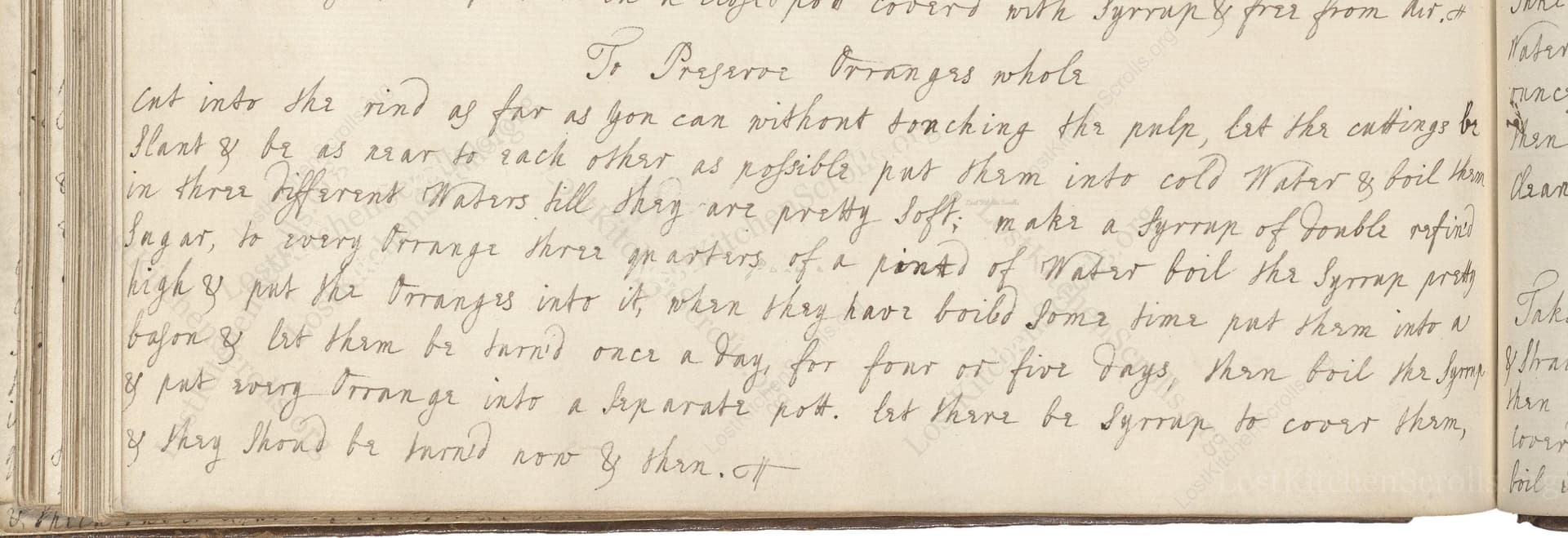To Preserve Oranges Whole
From the treasured pages of Cookbook of 1720 approximately
Unknown Author

To Preserve Oranges Whole
"cut into the rind as far as you can without touching the pulp, let the cuttings be slant & be as near to each other as possible put them into cold Water & boil them in three different Waters till they are pretty soft, make a Syrrup of double refined Sugar, to every Orange three quarters of a pint of Water boil the Syrrup pretty high & put the Oranges into it, when they have boild some time put them into a bason & let them be turnd once a day, for four or five Days, then boil the Syrrup & put every Orange into a separate pott. let there be Syrrup to cover them, & they should be turnd now & then."
Note on the Original Text
This recipe is written in a free-flowing narrative style typical of early 18th-century kitchens. The instructions assume familiarity with techniques like 'boiling high' (cooking the syrup until thickened) or turning fruit during preservation. Quantities were often relative, balancing the available fruit and sugar on hand. Spelling reflects the period’s loose conventions—‘Syrrup’ for ‘syrup’, and ‘bason’ for ‘basin.’ Punctuation and sentence structure are also more fluid than in modern recipes, relying on the reader’s good judgment and experience.

Title
Cookbook of 1720 approximately (1720)
You can also click the book image above to peruse the original tome
Writer
Unknown
Era
1720
Publisher
Unknown
Background
A delightful window into early 18th-century kitchens, this historical culinary tome brims with recipes, culinary wisdom, and the flavors of a bygone era—offering food enthusiasts a taste of both tradition and intrigue.
Kindly made available by
Folger Shakespeare Library
This recipe comes from approximately 1720, a time when preserving whole fruit in sugar syrup was both a practical necessity and a display of culinary skill. Oranges, once a luxury in England, had become more widely available but were still prized, especially as gifts or for decorative desserts at the table. Sugar was expensive and often seen as a mark of status, so recipes like this showcased both wealth and the ability to master intricate kitchen arts. Such preserves would adorn dessert courses or be enjoyed as sweets at festive occasions.

Cooks of the 18th century used large copper or earthenware pots for boiling. A wooden spoon would stir both water and syrup. Tongs or slotted spoons eased the oranges in and out of the hot liquid. The syrup and fruit would cool in a wide pottery basin. For storage, glazed earthen jars or glass pots were used, tightly sealed with parchment or cloth tied with string. A hearth fire would provide the heat, and timing was judged by eye and experience rather than thermometers or modern timers.
Prep Time
30 mins
Cook Time
1 hr 25 mins
Servings
4
We've done our best to adapt this historical recipe for modern kitchens, but some details may still need refinement. We warmly welcome feedback from fellow cooks and culinary historians — your insights support the entire community!
Ingredients
- Whole oranges, 4 medium (approx. 7 oz each; substitute: Seville oranges for a bitter edge, or standard sweet oranges)
- Double refined (white granulated) sugar, 1 lb 5 oz
- Water, 3 1/4 cups
Instructions
- Begin by scoring the rind of each orange with slanting cuts, as close together as possible, taking care not to pierce the juicy pulp.
- Place the whole oranges into a large pot of cold water.
- Bring to a boil, then drain and repeat this process twice more, for a total of three separate boils.
- This softens and detoxifies the rind, making it pleasant to eat.
- For the syrup, combine 3 1/4 cups of water for every four oranges with an equal weight of double-refined sugar (use 1 lb 5 oz sugar per four oranges).
- Bring the mixture to a high boil until you get a glossy and slightly thickened syrup.
- Add the boiled oranges to the hot syrup and simmer gently for 10–15 minutes.
- Transfer both oranges and syrup to a large bowl and allow them to sit, turning the oranges each day for four or five days so the syrup penetrates fully.
- Finally, place each orange in its own sterilized jar, covering completely with the syrup.
- Store the jars in a cool place and turn them occasionally to keep the fruit evenly preserved.
Estimated Calories
380 per serving
Cooking Estimates
You will spend about 30 minutes preparing and scoring the oranges. Boiling the oranges will take about 45 minutes in total. Cooking the syrup and simmering the oranges adds another 40 minutes. Most of the preservation time is hands-off, but you will need to turn the oranges each day for 4 to 5 days to let the syrup soak in.
As noted above, we have made our best effort to translate and adapt this historical recipe for modern kitchens, taking into account ingredients nowadays, cooking techniques, measurements, and so on. However, historical recipes often contain assumptions that require interpretation.
We'd love for anyone to help improve these adaptations. Community contributions are highly welcome. If you have suggestions, corrections, or cooking tips based on your experience with this recipe, please share them below.
Join the Discussion
Rate This Recipe
Dietary Preference
Main Ingredients
Culinary Technique

Den Bockfisch In Einer Fleisch Suppen Zu Kochen
This recipe hails from a German manuscript cookbook compiled in 1696, a time whe...

Die Grieß Nudlen Zumachen
This recipe comes from a rather mysterious manuscript cookbook, penned anonymous...

Ein Boudain
This recipe comes from an anonymous German-language manuscript cookbook from 169...

Ein Gesaltzen Citroni
This recipe, dating from 1696, comes from an extensive anonymous German cookbook...
Browse our complete collection of time-honored recipes



